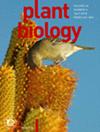猴子作为新热带香草种子传播者涉及社会学习。
IF 3.6
3区 生物学
Q1 PLANT SCIENCES
引用次数: 0
摘要
社会学习包括个人通过观察和与父母和社区成员的互动获得关于环境和行为的新信息的过程。在香草兰属中,种子的传播是由脊椎动物介导的。虽然在实验条件下从未观察到灵长类动物食用香草豆荚,但猴子被认为可能是巴西中部香草种子的传播者。本文通过实地观察、果实和种子的形态解剖、香味分析、奖励物质分析以及种子在消化道中的生存能力检测,研究了新热带香草种子传播者的吸引和奖励机制。此外,还进行了一项实验,以检验香草中的水果消费是否涉及某种社会学习。pompona的开裂果实被哺乳动物食用:猴子、老鼠和有袋动物。除了在胎盘和脐中提供营养奖励外,果壁还富含草酸钙晶体,这对哺乳动物是有毒的。因此,种子传播者通过果瓣进入果腔。虽然灵长类动物是自然种群中主要的种子传播者,但没有猴子在香草栖息地之外吃水果。白天和夜间的哺乳动物都吃香草果,这证明了视觉和嗅觉线索在吸引种子传播者方面的重要性。在资源丰富的环境中,食用未被识别或有害的水果似乎不是一个好的选择。猴子需要一段时间的资源短缺来刺激和学习如何安全地食用香草水果。将这些水果纳入有知识的个人的饮食后,信息通过社会学习传递给naïve个人。这是首次将猴子描述为兰花种子传播者的研究。本文章由计算机程序翻译,如有差异,请以英文原文为准。

Monkey as seed dispersers of Neotropical Vanilla involves social learning
求助全文
通过发布文献求助,成功后即可免费获取论文全文。
去求助
来源期刊

Plant Biology
生物-植物科学
CiteScore
8.20
自引率
2.60%
发文量
109
审稿时长
3 months
期刊介绍:
Plant Biology is an international journal of broad scope bringing together the different subdisciplines, such as physiology, molecular biology, cell biology, development, genetics, systematics, ecology, evolution, ecophysiology, plant-microbe interactions, and mycology.
Plant Biology publishes original problem-oriented full-length research papers, short research papers, and review articles. Discussion of hot topics and provocative opinion articles are published under the heading Acute Views. From a multidisciplinary perspective, Plant Biology will provide a platform for publication, information and debate, encompassing all areas which fall within the scope of plant science.
 求助内容:
求助内容: 应助结果提醒方式:
应助结果提醒方式:


